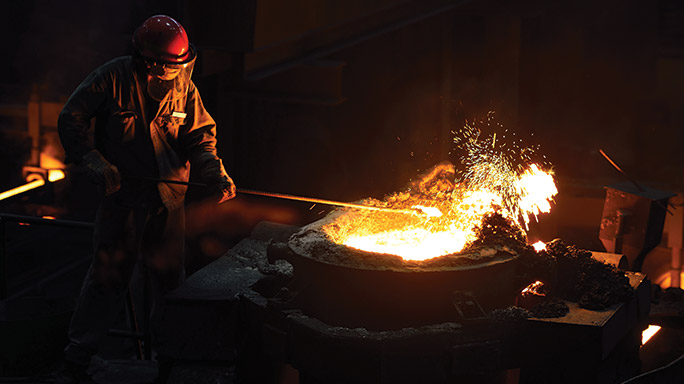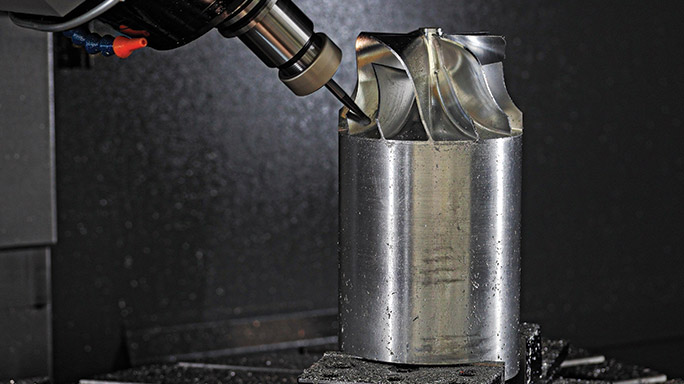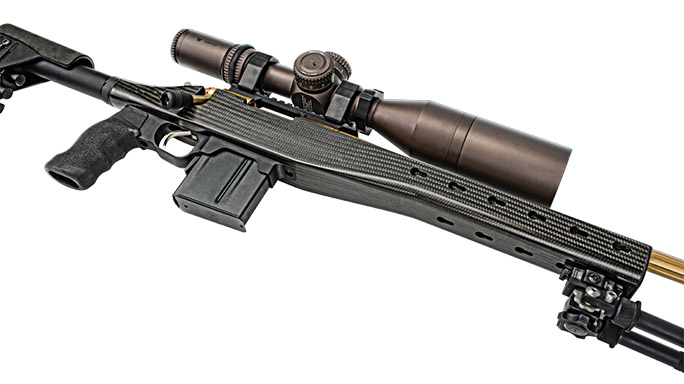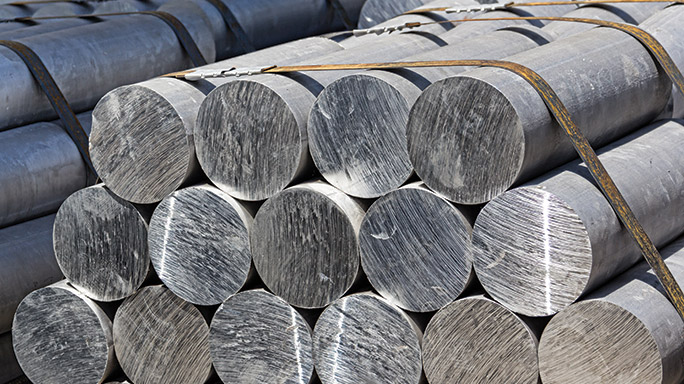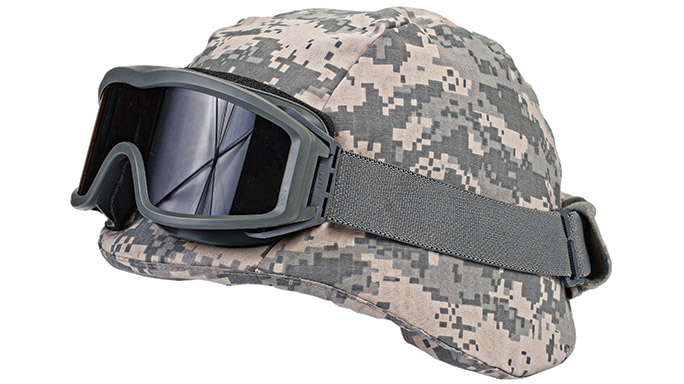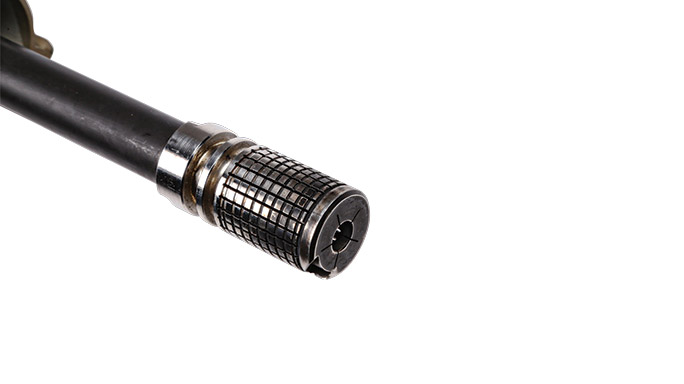Whether we realize it or not, most of us interact with advanced materials every day. You may have Kevlar in your shoes or carbon fiber in your car. Some of us might even have titanium implants in our bodies. These miracles of innovation may have started as science experiments in some mysterious lab, but they’re now a part of our daily lives—and for many of us, even present in our firearms, survival gear and safety equipment, too.
- RELATED STORY: The Best 20 Next-Gen Gun Silencers For 2016
To better understand how these materials work for us, let’s delve deeper into their advantages and what we can expect from them.
Carbon Fiber
Advertisement — Continue Reading Below
At one time, carbon fiber was reserved for use in only the most cutting-edge machinery. From Formula 1 cars to the Space Shuttle, carbon fiber was the material of the future. Nowadays, we find this advanced material in use in everyday items such as golf clubs and even wallets. It’s only natural that carbon fiber found its way to the firearms world, too.
Carbon-fiber-wrapped rifle barrels, handguards, buttstocks and even bolt-action chassis are now appearing en masse. Aside from the futuristic look, what advantages can shooters expect from its magic weaves? According to a recent study, carbon-fiber composites are 3.8 times stronger than steel, 4.5 times stronger than aluminum alloys and 7.4 times stronger than titanium. The material is stiffer and lighter than traditional metals as well. In fact, it’s said that carbon fiber is up to 70 percent lighter than steel and 40 percent lighter than aluminum. Understanding this makes the advantages of using carbon-fiber composites obvious.
Its high corrosion resistance added to its superior strength-to-weight ratio make it a natural fit in the “ounces equal pain” mantra of the tactical and survival worlds. Rifle barrels are another beneficiary of this material: Carbon-fiber-wrapped barrels were once considered gimmicks, but over the years many shooters have found that the weight savings and cooling properties equate to barrels they can carry farther and with less fatigue. In fact, carbon-fiber-wrapped barrels oftentimes weigh half or less than that of a steel barrel of the same profile. At the same time, these barrels maintain their accuracy and last longer than standard steel barrels.
Advertisement — Continue Reading Below
Kevlar
Poly-paraphenylene terephthalamide, aka Kevlar, is commonly used as a protective material and is employed extensively in everything from motorcycle safety gear to military-grade body armor. In fact, the gloves you see on the cover of this magazine contain Kevlar. The material has a high-tensile strength-to-weight ratio and is said to be approximately five times stronger than steel.
Kevlar protects particularly well against cuts, abrasions and heat. It is used in gear worn by firefighters as well as athletes such as speed skaters and fencers. Hunters and fishermen will be familiar with its use in gloves that protect from accidental knife cuts. Protective gear such as body armor that incorporates the use of Kevlar is usually much lighter and thinner than gear of an equivalent protective value that’s made of more conventional materials.
Advertisement — Continue Reading Below
Titanium
Do you think titanium is rare? We thought so too until we did our research. Titanium is actually one of the top 10 most abundant elements found in the Earth’s crust. If it’s so abundant, then why is it so expensive? The answer lies in its production. Titanium must be processed in a complex, time-consuming and labor-intensive process. So from a certain point of view, it’s still considered rare.
Titanium is most prized for its corrosion resistance and the fact that it has the highest strength-to-density ratio of any other metallic element. When used as an alloying agent and mixed with other metals such as aluminum, titanium alloy becomes a very strong yet lightweight material. The material is frequently used in aircraft, naval ships and even missiles due to its high corrosion and fatigue resistance as well great tensile strength-to-density ratio.
Advertisement — Continue Reading Below
Yes, titanium may be expensive, but it’s no longer a material reserved for those with the spending budget of the Department of Defense. Recently, companies such as V Seven Weapon Systems have been pioneering the use of titanium in relatively affordable gun components such as AR-15 gas blocks and takedown pins. To see what other titanium parts you can use to bling out your rifle, take a look at the titanium AR-15 parts buyer’s guide elsewhere in this issue.
Inconel
Inconel is a corrosion-resistant material that is used in very high-temperature and high-pressure applications. It retains strength over a wide and high temperature range and is employed where traditional materials such as aluminum and steel would fail. SpaceX uses Inconel in the engine manifold of its Merlin rocket engines. Common uses include gas turbine blades and turbocharger rotors.
Advertisement — Continue Reading Below
In the firearms world, Inconel can be found inside the high-pressure, high-temperature spaces within a sound suppressor as blast baffles. Because it is difficult to machine, often ruining the very tool trying to cut it, Inconel parts can be expensive to produce.
Stainless & Carbon Steel
Though not really considered an “advanced material” anymore, we thought we’d include steel to explain the meaning of all those numbers you read in firearm and knife specifications. You’ve seen designations like 4140 steel or 17-4 stainless before—in fact, you’ve probably seen them in this very issue. To understand these names, let’s learn a little bit about steel.
Advertisement — Continue Reading Below
Steel is an alloy of iron with enough carbon and other elements in it to allow for hardening. The definition of carbon steel can get very particular, but generally the term covers most steels that are not stainless steel, including different alloy steels. The more carbon steel has, the greater its ability to become harder and stronger through heat treatment; but too much carbon makes steel less ductile, or unable to be deformed without becoming weak and brittle.
Alloying agents mixed with steel give the material different attributes, such as corrosion resistance, increased strength, decreased brittleness, easier machinability and so forth. The Society of Automotive Engineers (SAE) establishes the designations for these various steel alloys by way of a four-number designation system. Classifications like the ones we commonly see in the firearms world, such as 4140 and 4150, designate the contents of a certain type of steel. The first number represents the material’s class, in this case molybdenum steel, the second digit indicates the secondary alloying element, and the final two numbers indicate the amount of carbon it contains. It can get more detailed, but since this isn’t a metallurgical class, we’ll move on.
So what’s the difference between 4140 and 4150 steel? As you can see by their SAE designation, they’re similar in most aspects except for the amount of carbon in them. The 4140 has enough carbon content in it—0.40 percent carbon by mass—to make it hard enough yet malleable enough to be used extensively and reliably in the firearms world. The 4150, however, increases the carbon content to 0.50 percent, which makes it a much harder material. This additional hardness means it is more durable, but it’s also harder to work with, which usually equates to increased cost.
Advertisement — Continue Reading Below
Stainless steel is a steel alloy with a minimum of 10.5 percent chromium content by mass, which means it won’t easily corrode, rust or stain. Those of us who are around guns and knives are most familiar with 416 or 440 stainless steel. The 416 is commonly used in firearms and has added sulfur content that makes it easier to machine, while 440 stainless is a higher grade of cutlery steel with more carbon content. This means that the 440 is preferred by knife-makers for its ability to better retain sharp edges. When hardened, it is one of the hardest stainless steels available.
There are different grades of 440; 440C has the highest carbon content. The next time you are comparing products, don’t quickly shrug off the designation differences as something minor. Just a single changed digit can mean a big difference in a material’s performance and durability characteristics.
Aluminum
Advertisement — Continue Reading Below
Like steel, we see all sorts of aluminum designations being thrown around—6061 this and 7075 that. So what’s the difference? Well, 6061 is an aerospace-grade aluminum alloy that contains magnesium and silicon as its major alloying elements. It is easy to work with and is used for everything from flashlight bodies to firearm receivers.
The type known as 7075 is a stronger-grade aluminum alloy that has zinc as its primary alloying element. Its strength is comparable to many grades of steels, and it has good fatigue resistance. It isn’t as easy to machine as 6061, though, and its relatively high cost limits its use. Its strength also lies in its high level of corrosion resistance.
What’s up with the suffixes after some designations? Sometimes you’ll see a dash, a letter and a number after an aluminum designation. This signifies its temper designation. We usually encounter the suffixes “-T6” or “-T7.” “T” means that the alloy is heat-treated for improved hardness and elasticity. Specifically, “T6” means that the aluminum has been solution heat-treated and artificially aged, while “T7” is also solution heat-treated but is then stabilized for greater durability.
- RELATED STORY: Advanced Armor: Morgan Advanced Materials
So, going back to 6061 aluminum—its strength can vary greatly depending on how it’s tempered. Regular 6061 has a maximum tensile strength of 18,000 psi and is used for items such as automotive parts and aluminum cans. However, 6061-T6 has an ultimate tensile strength of at least 42,000 psi and is used for bicycle frames and AR-15 receivers, among other items. As with steel, a seemingly small change in designation can equate to a very different material.
There you have it. Use your newfound knowledge wisely.
